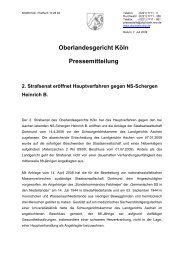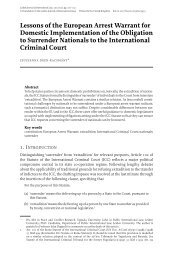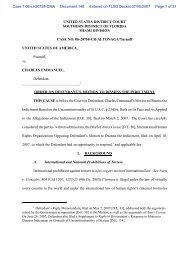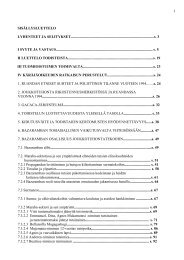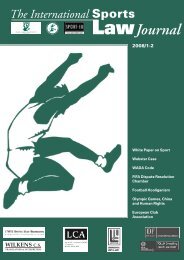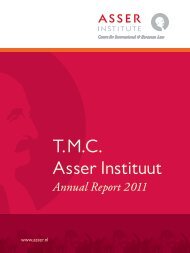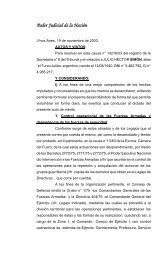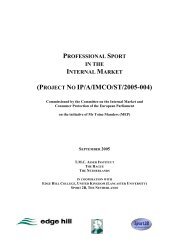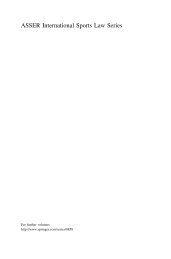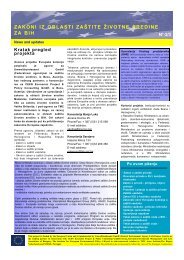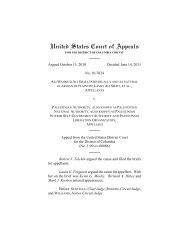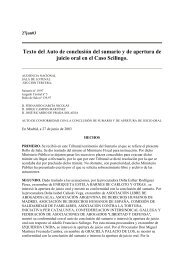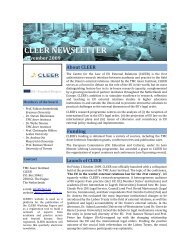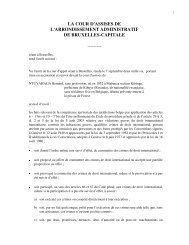Islj 2009 3-4 - TMC Asser Instituut
Islj 2009 3-4 - TMC Asser Instituut
Islj 2009 3-4 - TMC Asser Instituut
You also want an ePaper? Increase the reach of your titles
YUMPU automatically turns print PDFs into web optimized ePapers that Google loves.
exercise of various international legal capacities by IGOs and the<br />
arguments for extension of similar capacities to NGOs when warranted,<br />
173 the IOC may yet see its eighty-seven-year old claim accommodated<br />
by international law. This is because, more so than ever in its<br />
history, the Olympic organization “manifests traits and actions characteristic<br />
of international organizations.” 174<br />
The purposes of the Olympic movement are broad and public in<br />
nature. They include: “to educate young people through sport in a<br />
spirit of better understanding … and of friendship, thereby helping to<br />
build a better and more peaceful world,” and “to spread the Olympic<br />
principles throughout the world, thereby creating international goodwill.”<br />
175 The organization is truly neutral in character. Political, racial<br />
and religious discrimination are explicitly prohibited in the<br />
Charter. 176<br />
With members from over fifty countries, participation in the IOC<br />
is nearly universal. Among NGOs, the IOC is a unique example of a<br />
membership system in which the members are selected not as representatives<br />
of states or other international organizations, but as the<br />
organization’s representatives to national and international organizations.<br />
177 Rule 12 provides in part: “Members of the IOC are representatives<br />
of the IOC in their countries and not their delegates to the<br />
IOC. They may not accept from governments or from any organizations<br />
or individuals instructions which shall in any way bind them or<br />
interfere with the independence of their vote.” 178<br />
The political structure of the Olympic organization is truly<br />
transnational. Although the IOC is the governing body, the organization<br />
also includes the Olympic Congress, the National Olympic<br />
Committees and International Sports Federations. National<br />
Committees are recognized by the IOC and required to be<br />
“autonomous and … [to] resist all pressures of any kind whatsoever,<br />
whether of a political, religious, or economic nature,” 179 These<br />
Committees, representatives of the twenty-six International Sports<br />
Federations 180 and IOC members constitute the Olympic Congress. 181<br />
The Olympic organization makes its own rules, legislates and<br />
administrates within its area of competence. The movement has been<br />
largely transformed from one which relied upon “discretionary decision-making”<br />
to one which uses a “quasi-legal process of rule-creation<br />
and supervision.” 182 The Charter now contains seventy-one rules,<br />
detailed by-laws and instructions to hosts of the games on every<br />
aspect of procedure and administration, all drafted by a “Legislation<br />
Commission” appointed by the IOC. 183<br />
Finally, the IOC enforces its rules through judicial and arbitral proceedings.<br />
Rule 23 provides that “The IOC is the final authority on all<br />
questions concerning the Olympic Games and the Olympic movement.”<br />
184 The by-laws provide for the delegation of authority, hearing<br />
procedures and penalties for breach of IOC rules. 185<br />
Together, these characteristics and activities make the Olympic<br />
organization a significant transnational actor. 186 The relationships<br />
between the IOC, the international sports federations and the national<br />
committees are governed only by IOC regulations. Yet they impose<br />
a potent transnational legal order on a distinct area of transnational<br />
sporting activity. 187 Functionally, the activities of the Olympic movement<br />
make it as much an international actor as most of the narrow<br />
purpose IGOs.<br />
3. Current Legal Status of NGOs<br />
Scholarship on the question of the legal status of NGOs is scarce.<br />
Many scholars holding a progressive view argue that the requirements<br />
of international life are now such that certain NGOs should be<br />
embraced as international persons; some maintain that they already<br />
are. 188 The great majority of lawyers and scholars, however, have concluded<br />
that NGOs are currently governed by their constitutive instruments<br />
and by the municipal law of the state pursuant to which they<br />
have been established. 189 But those who advance the argument that<br />
NGOs should be or are international entities make arguments worth<br />
examining.<br />
Scholars holding a progressive view ask how the law can continue<br />
to deny international legal personality to NGOs, organizations that<br />
are functionally identical to IGOs and lack only the IGOs’ imprimatur<br />
of sovereign membership. These scholars contend that the<br />
functional principle requires the disregard of the fiction of collective<br />
sovereignty that arises simply from an IGOs’ sovereign membership.<br />
One response is that the fiction of collective sovereignty cannot he<br />
disregarded. Its continuing importance is manifested in the positive<br />
doctrine of international law that individuals, whether natural or corporate,<br />
cannot be the subjects of international law. 190 Although challenged<br />
by some scholars in connection with the development of<br />
human rights law, 191 the old rule stands and is vehemently defended,<br />
especially by socialist international lawyers. 192 One author believes this<br />
adherence to the old rule to be the principal barrier to the recognition<br />
of the international legal personality in NGOs. 193<br />
Nonetheless, in advocating international legal status for NGOs,<br />
Brownlie notes that “Whilst due regard must be had to legal principle,<br />
the lawyer cannot afford to ignore entities which maintain some sort<br />
of existence on the international legal plane in spite of their anomalous<br />
character.” 194 In a similar vein, Lador-Lederer argues forcefully that the<br />
existence maintained by NGOs on the international plane reveals<br />
functional attributes identical with those which result in international<br />
personality for States and IGOs. 195 Based en an examination of NGOs<br />
like the Holy See 196 and the International Committee of the Red<br />
Cross, 197 he observes:<br />
The organizations in question are seen to be within the law by<br />
virtue of their doing what constitutes statehood: by legislating<br />
within the range of their functions, by administering the law within<br />
the range of their authority, by adjudicating subjective rights<br />
within their jurisdiction, acting in the spirit of their legislation. …<br />
173 See text accompanying notes 188-212<br />
infra.<br />
174Espy, supra note 22, at 9.<br />
175 Olympic Charter, Rule 1 (prov. ed.<br />
1980). The other aims set forth in Rule 1<br />
are “to promote the development of<br />
those physical and moral qualities which<br />
are the basis of sport,” and to “bring<br />
together the athletes of the world in the<br />
great four-yearly sport festival, the<br />
Olympic Games.” Id.<br />
176Olympic Charter, Rule 3 (prov. ed,<br />
1980). See Leyendecker, supra note 171,<br />
at 42.<br />
177See L. White, International Non-<br />
Governmental Organizations 199 (1951).<br />
178Olympic Charter, Rule 12 (prov. ed.<br />
1980).<br />
179Id. Rule 24(C).<br />
180Id. Rule 45.<br />
181 Id. Rule 17(C).<br />
182 Nafgziger, supra note 61, at 181 n. 2.<br />
183 Id, at 190-91.<br />
184Olympic Charter, Rule 23 (prov. ed.<br />
1980).<br />
185 Id. By-laws to Rules 16 and 23.<br />
186Espy, supra note 22, at 16.<br />
187Leyendecker, supra note 171, at 48.<br />
188 See, e.g., Lador-Lederer, supra note 165,<br />
at 14-15.<br />
189Leyendecker, supra note 171, at 42-43.<br />
190See 1 M. Whiteman, Digest of<br />
International Law 238 (1973). But see<br />
Brownlie, supra note 82, at 69. “There is<br />
no general rule that the individual cannot<br />
be a ‘subject of international law’<br />
and in particular contexts he appears as<br />
a legal person on the international<br />
plane.” Id.<br />
191 Dean, Beyond Helsinki: The Soviet View<br />
of Human Rights in International Law,<br />
21 Va. J. Int’l L. 55, 72-74 (1980). See,<br />
e.g., W. Gormiey, The Procedural Status<br />
of the Individual Before International<br />
and Supranational Tribunals 30-31<br />
(1966); H. Lauterpacht, International<br />
Law and Human Rights 27-35 (1968).<br />
192“[The extension of subject status to individuals]<br />
contradicts the very essence of<br />
International Law.” F. Kozevnikov,<br />
International Law: A Textbook for Use<br />
in Law School 89 (1957), quoted in<br />
Dean, Beyond Helsinki: The Soviet View<br />
of Human Rights in International Law,<br />
21 Va. J. Int’l L. 55, 72-74 (1980).<br />
193 … [l]e principal obstacle à la reconnaissance<br />
de cette même personalité aux<br />
organisations internationales non-gouvernementales.”<br />
Leyendecker, supra note<br />
171, at 43.<br />
194Brownlie, supra note 82, at 67.<br />
“Furthermore, as elsewhere in the law,<br />
provided that no rule of jus cogens is<br />
broken, acquiescence, recognition, and<br />
the incidence of voluntary bilateral relations<br />
can do much to obviate the more<br />
negative consequences of anomaly.” Id.<br />
at 59.<br />
195 Lador-Lederer, supra note 165, at 59-68.<br />
Similar functional attributes are shared<br />
by international public corporations. See<br />
generally Friedman, supra note 159.<br />
These bodies, like the Bank for<br />
International Settlements, see Hague<br />
Convention, Jan. 20, 1930, 104 L.N.T.S,<br />
441, are international in character, have<br />
managerial and financial autonomy, own<br />
their own funds, perform an international<br />
public service, and are constituted in a<br />
multinational convention. It is only in<br />
respect to the last characteristic that they<br />
differ from most NGOs. Friedman,<br />
supra note 159, at 186, 191; Kunz. supra<br />
notc 74, at 850-51.<br />
196See, eg.. Lador-Lederer, supra note 165,<br />
at 29-32, 60, 210-11.<br />
197See generally Picet, La Croix et les<br />
Convenitons de Genève, 76 Recueil des<br />
Cours 5 (1950: I).<br />
156 <strong>2009</strong>/3-4<br />
H I S T O RY



